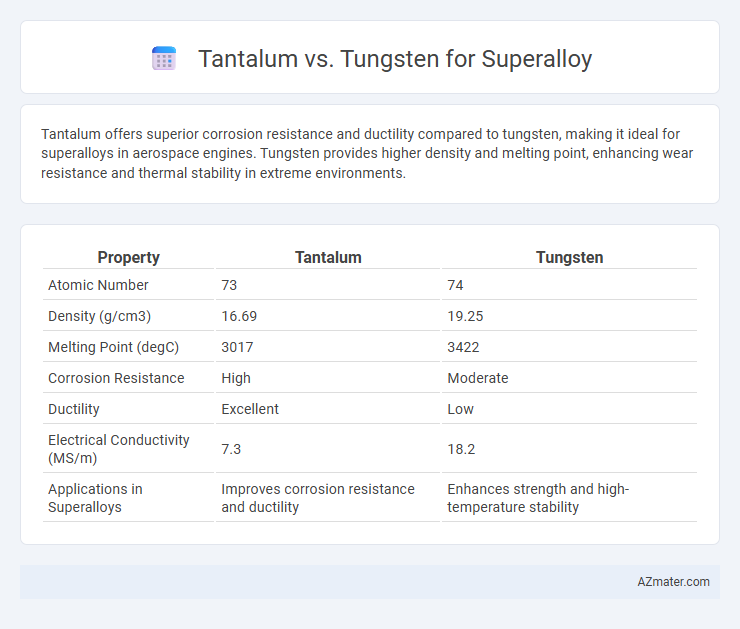Tantalum offers superior corrosion resistance and ductility compared to tungsten, making it ideal for superalloys in aerospace engines. Tungsten provides higher density and melting point, enhancing wear resistance and thermal stability in extreme environments.
Table of Comparison
| Property | Tantalum | Tungsten |
|---|---|---|
| Atomic Number | 73 | 74 |
| Density (g/cm3) | 16.69 | 19.25 |
| Melting Point (degC) | 3017 | 3422 |
| Corrosion Resistance | High | Moderate |
| Ductility | Excellent | Low |
| Electrical Conductivity (MS/m) | 7.3 | 18.2 |
| Applications in Superalloys | Improves corrosion resistance and ductility | Enhances strength and high-temperature stability |
Introduction: The Role of Superalloys in Modern Engineering
Superalloys, essential in aerospace and power generation, rely on elements like tantalum and tungsten for enhanced high-temperature strength and corrosion resistance. Tantalum contributes to improved ductility and oxidation resistance, while tungsten offers superior mechanical stability and melting point elevation. These properties enable superalloys to maintain performance in extreme environments, optimizing engine efficiency and durability.
Tantalum vs Tungsten: Key Material Properties
Tantalum exhibits superior corrosion resistance and higher ductility compared to tungsten, making it ideal for superalloy applications requiring enhanced durability under extreme temperatures. Tungsten, however, has a significantly higher melting point (3422degC vs. 3017degC for tantalum) and exceptional hardness, providing excellent wear resistance and thermal stability in high-stress environments. The choice between tantalum and tungsten in superalloys depends on balancing corrosion resistance and toughness with melting point and mechanical strength.
Melting Points and High-Temperature Performance
Tantalum exhibits a melting point of approximately 3017degC, slightly lower than tungsten's higher melting point of around 3422degC, making tungsten preferable for environments demanding extreme heat resistance. In superalloy applications, tungsten offers superior high-temperature strength and oxidation resistance, enhancing durability in aerospace and turbine components. Tantalum's excellent corrosion resistance and ductility complement tungsten's thermal robustness, often leading to their combined use to optimize performance under high-temperature operational stress.
Corrosion and Oxidation Resistance Comparison
Tantalum exhibits superior corrosion resistance in aggressive environments due to its stable oxide film, making it ideal for superalloys exposed to highly oxidizing conditions. Tungsten offers excellent high-temperature oxidation resistance but is more susceptible to oxidation at temperatures above 600degC without protective coatings. In superalloy applications, tantalum enhances longevity in corrosive atmospheres, while tungsten provides strength under extreme thermal stress with moderate oxidation resilience.
Mechanical Strength Under Extreme Conditions
Tungsten exhibits superior mechanical strength and high melting point, making it ideal for superalloys used in extreme temperature and stress environments such as aerospace and nuclear reactors. Tantalum offers excellent corrosion resistance and good ductility but has lower tensile strength compared to tungsten under high-temperature conditions. The choice between tantalum and tungsten for superalloys depends on the balance between mechanical strength requirements and environmental factors like oxidation resistance.
Density and Weight Considerations
Tantalum exhibits a density of approximately 16.7 g/cm3, whereas tungsten is denser at about 19.3 g/cm3, making tungsten heavier for equivalent volumes. In superalloy applications where weight minimization is critical, tantalum's lower density offers advantages in reducing component mass without compromising corrosion resistance. Tungsten's higher density contributes to increased weight but provides exceptional high-temperature strength, influencing material selection based on specific performance and density requirements.
Machinability and Fabrication Challenges
Tantalum exhibits better machinability than tungsten due to its lower hardness and higher ductility, facilitating easier cutting and shaping during superalloy fabrication. Tungsten's extreme hardness and brittleness pose significant fabrication challenges, often requiring specialized tools and techniques to avoid excessive tool wear and material cracking. Both elements demand precise control of temperature and tooling conditions to optimize machinability and maintain structural integrity in superalloy production.
Cost Analysis and Material Availability
Tantalum offers superior corrosion resistance and high melting point but comes at a significantly higher cost compared to tungsten, impacting overall superalloy production budgets. Tungsten is more abundant and readily available, which reduces supply chain risks and market price volatility in superalloy manufacturing. Cost analysis reveals tungsten's economic advantage for large-scale applications, while tantalum is reserved for niche uses demanding extreme performance despite its expense.
Typical Applications in Superalloy Design
Tantalum enhances corrosion resistance and high-temperature strength in superalloys, making it ideal for aerospace turbine components and chemical processing equipment. Tungsten contributes exceptional wear resistance and thermal stability, commonly utilized in jet engine parts and high-performance cutting tools. Both elements are critical in superalloy design for applications requiring durability under extreme thermal and mechanical stress.
Choosing the Right Element: Tantalum or Tungsten?
Tantalum and tungsten both play critical roles in superalloy development, where tungsten offers superior high-temperature strength and thermal conductivity, making it ideal for components exposed to extreme heat, such as turbine blades. Tantalum provides excellent corrosion resistance and ductility, beneficial in superalloys used in aerospace and chemical processing applications where longevity and resistance to oxidation are paramount. Selecting between tantalum and tungsten depends on the specific operating conditions, with tungsten favored for thermal stability and strength, while tantalum excels in environments requiring enhanced corrosion resistance.

Infographic: Tantalum vs Tungsten for Superalloy
 azmater.com
azmater.com